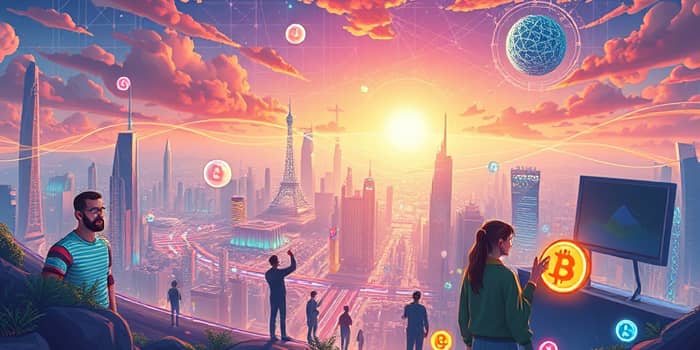Imagine stepping into a boundless digital universe where reality and imagination blend seamlessly. The metaverse isn’t just a sci-fi fantasy, but a rapidly evolving ecosystem reshaping our social, economic, and creative landscapes. At its core, blockchain and cryptocurrency power this revolutionary space, enabling new forms of ownership, value exchange, and decentralized governance.
Understanding the Metaverse
The term “metaverse” refers to a persistent virtual reality environment that coexists with our physical world. Through augmented reality (AR), virtual reality (VR), and advanced 3D avatars, users can interact, work, and play in shared digital spaces. Companies like Meta, Google, and Microsoft are investing heavily, betting on a future where digital communication platforms converge into one expansive universe.
These environments range from social hubs and gaming worlds to professional collaboration spaces. As AR glasses and VR headsets become more affordable, millions will join these immersive realms, forging new communities and economic opportunities.
The Explosive Market Growth
The metaverse market is expanding at a breathtaking pace. From a valuation of USD 94.1 billion in 2023, experts project a meteoric rise to USD 2,346.2 billion by 2032, representing a staggering CAGR of 44.4%. This surge is fueled by innovations in hardware, software, and blockchain integration. As of mid-2024, over 300 crypto-driven metaverse projects boast a collective market cap of $31.7 billion.
Investments pour in from venture capitalists and tech giants alike, eager to secure footholds in virtual real estate, digital commerce, and user-generated economies. This momentum underscores the metaverse’s potential to revolutionize every sector from education and training to entertainment and retail.
Cryptocurrency Driving Virtual Economies
At the heart of these digital worlds lies crypto, which serves as the primary medium of exchange and asset ownership. Platforms like Decentraland and The Sandbox rely on their native tokens—MANA and SAND respectively—for every transaction, from land purchases to digital fashion.
- Currency replacement for fiat transactions: Seamless, borderless payments without banks.
- User-generated economy empowerment: Creators monetize art, events, and services.
- Interoperability across diverse platforms: Assets move freely among virtual realms.
- Transparent decentralized governance models: Communities vote on development decisions.
Decentralization and Enhanced Security
Blockchain technology underpins the metaverse’s trust and security architecture. By distributing data across networks, it removes single points of failure and guards against censorship. Immutable ledgers ensure every transaction—from property transfers to digital art sales—is permanently recorded and verifiable.
Smart contracts automate agreements, eliminating intermediaries and reducing costs. Decentralized identity solutions empower users with full control over personal data, safeguarding privacy and streamlining authentication across multiple virtual environments.
Real-World Applications and User Experiences
Beyond gaming and socializing, the metaverse offers transformative use cases:
- Virtual collaboration hubs: Enterprises host meetings and training in fully immersive spaces.
- Play-to-earn gaming economies: Users earn crypto rewards for gameplay achievements.
- Digital commerce and virtual retail: Brands launch immersive storefronts for global audiences.
- Educational simulations: Interactive lessons in history, science, and professional skills.
These experiences are enhanced by realistic graphics, haptic feedback, and AI-driven NPCs, creating lifelike interactions that mirror—and sometimes surpass—physical reality.
Opportunities and Advantages for Users
For individuals, the metaverse unlocks unprecedented opportunities:
True digital ownership means you control your virtual assets, not platform providers. Through NFTs, every item—be it land, art, or wearables—carries verifiable provenance and scarcity. This fosters a thriving creative ecosystem where artists and developers earn direct rewards for their contributions.
Portable value across platforms lets users carry avatars, items, and currencies from one world to another, fostering a cohesive digital identity. Aspiring entrepreneurs can launch virtual businesses, host paid events, and monetize skills in ways previously unimaginable.
Challenges and Risks Ahead
Despite its promise, the metaverse faces significant hurdles:
- Security vulnerabilities: Identity theft, smart contract bugs, and fraud require robust safeguards.
- Platform fragmentation: Lack of universal standards hampers asset portability.
- Regulatory and legal ambiguity: Jurisdictional complexities around digital property rights.
Developers and policymakers must collaborate to establish interoperability protocols, regulatory frameworks, and best practices to mitigate risks while preserving innovation.
The Road Ahead: Future Outlook
Advancements in AI, VR, and AR will deepen immersion, making virtual experiences indistinguishable from reality. As more industries—from healthcare and education to entertainment and real estate—adopt metaverse strategies, user adoption will accelerate.
Interoperability standards, enhanced security solutions, and clear regulations will pave the way for a truly unified digital universe. In this evolving landscape, individuals and organizations can harness endless creative possibilities, shaping a more connected, equitable, and innovative world.
Embrace the metaverse today, and be part of a movement that redefines human interaction, commerce, and creativity for generations to come.
References
- https://bravenewcoin.com/sponsored/article/top-metaverse-crypto-projects-to-invest-in-january-2025
- https://www.nextechar.com/blog/the-role-of-blockchain-in-securing-the-metaverse
- https://www.cyberpeace.org/resources/blogs/metaverse-crypto-the-creative-and-digital-future
- https://www.eimt.edu.eu/how-blockchain-powers-the-metaverse-economy
- https://blockchaintechs.io/top-metaverse-projects-to-watch-out-in-2025/
- https://cointelegraph.com/learn/articles/what-is-metaverse-in-blockchain
- https://www.kucoin.com/learn/web3/top-metaverse-crypto-projects-to-watch
- https://www.xrtoday.com/mixed-reality/the-metaverse-blockchain-connection-a-definition/










